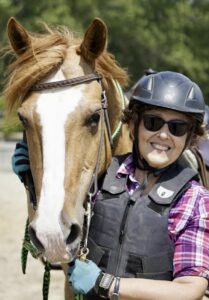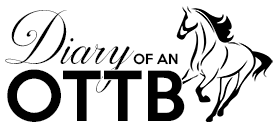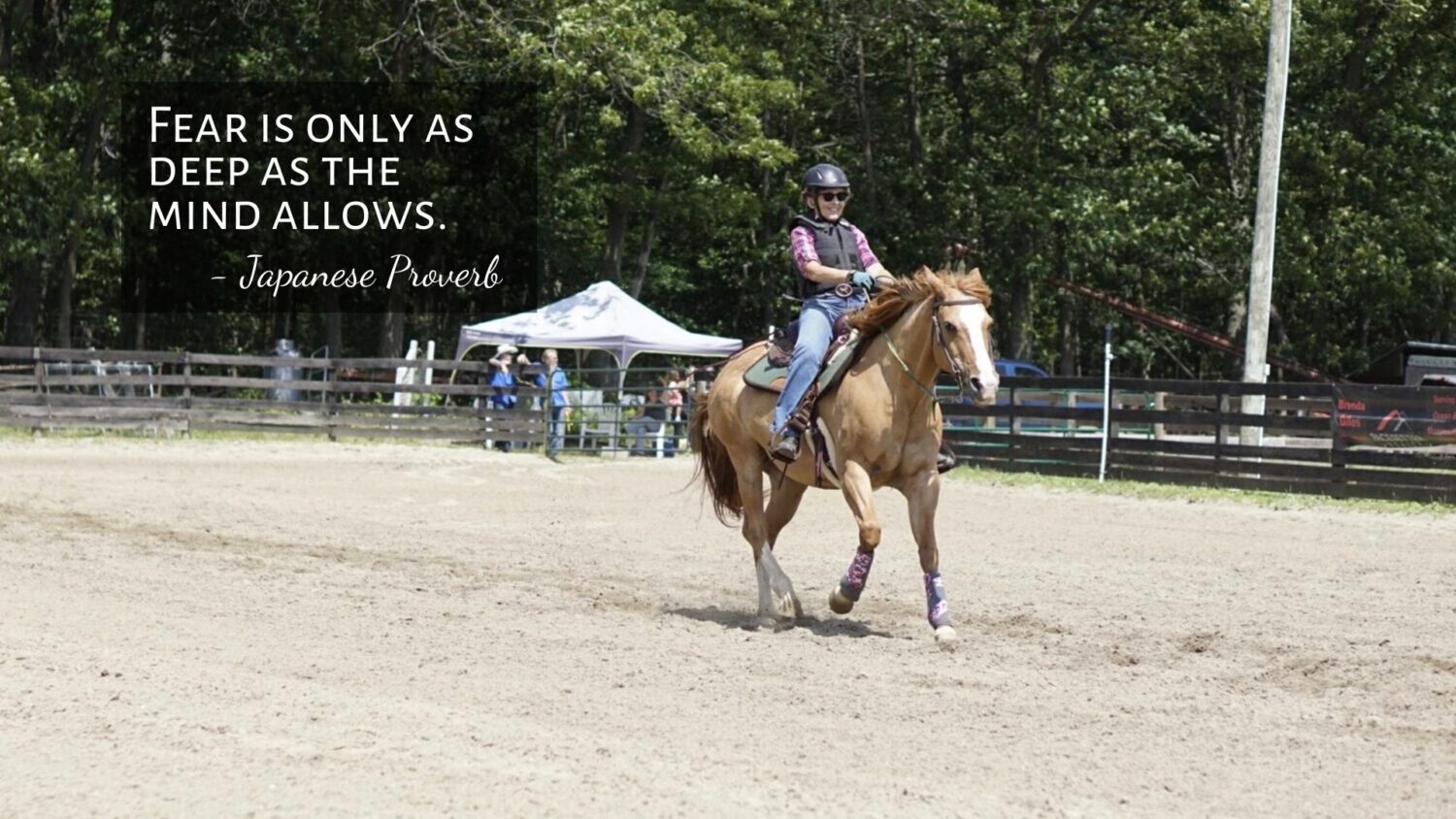I’m no expert on the inner workings of the human mind but I understand why some people are afraid of horses. As the owner of a sometimes fire-breathing off the track thoroughbred, I’ve had my share of days that have made me question why I’m working or better yet, RIDING, an animal that weighs anywhere from 800-1300 lbs.
The reality is that fear is a natural part of self-preservation but if you want to be a confident rider you have to be able to work with your fear in order to grow through it.
My fiancée Lisa deals with this subject on an almost daily basis as a professional horse trainer. Many of her students are just starting their riding careers while others might be seasoned horse veterans that are so stricken by fear they can’t get on their horse anymore. I spoke with Lisa and one of her students, Louise Walpin, who started her riding career battling a near paralyzing fear of riding and working with horses, but she was determined to get through it. We discussed what it takes to overcome that fear and the all-important role that a confidence building horse can play in helping improve the mentality of a timid rider.
To start our conversation I asked Lisa what she initially recommends for students with a lot of fear. “If you have a lot of fear as a rider, there are a few things I immediately recommend: If you don’t already work with a trainer, find a good reputable instructor who can help you build the basic foundation for riding that will keep you safe. And the second thing is to find a horse that can help build your confidence. A bucking bronco or green project pony isn’t going to be a good fit for these riders. I myself was a fearful rider when I first started out and that helps me connect with many of my students who are a little nervous starting out. It’s very much an, ‘I know you because I was you’ situation for me.”
Originally from New York City, Louise started her riding career in early 60s. With that lack of farm and horse experience also came a great deal of fear. But through years of regular lessons, even in the snow and cold, Louise has improved dramatically and learned more about her own capabilities and the nature of horses as prey animals.
“My fear was a 20 on a scale of 1-10,” said Louise. “I was convinced horse movement was dangerous: I froze, held my breath and couldn’t think, but I persisted. I learned that horses have the ability to sense our breath, heart rate and fear. When they perceive the rider is frightened, as prey animals, they too become scared. What a dilemma: I was determined to ride, was frozen with fear, but realized that fear actually increased my risk of injury. To top it all off my trainer kept telling me I had to ‘direct my horse with the proper amount of energy; show intention.’ I kept asking myself, ‘What does that mean?’ I had no idea, but I trusted her implicitly so I kept storing all she taught me in my brain, figuring maybe I’d be able to access it one day.”
Knowing that fear is such a basic instinct, I asked Lisa whether fear could ever be used as a tool. “Fear can absolutely be an asset to riders and working with horses in general. Many of my fearful students often go on to become good riders because they’re able to focus and pay close attention to details with their own movements and their horse’s behavior because as far as they’re concerned their life literally depends on it. My job is really a balance of accommodating the rider with a horse that won’t overwhelm the student. These horses can often be characterized as lazy, stubborn, and insensitive, but those horses are almost always the ones that offer the largest margin for error for beginner riders because they ignore excess movement, tension, and noise from the rider. But when the mistakes fall away and the student learns to ask correctly, clearly and with intention that same stubborn horse will reward them with the correct response. and usually nothing else that requires additional effort.”
As Louise’s riding lessons and horsemanship skills progressed while riding a number of horses in Lisa’s lesson program, along came a little horse named Candie.
Lisa explained, “The horse world is always a small one and a friend of a friend had a lesson horse that I wanted to take a look at. We drove just a few miles down the road from our farm and there we met Candie – a little mare who’d spent previous years playing games with kids and giving lessons to absolute beginners. Meghan and I both hopped on Candie and walk, trot, cantered. I did my usual potential lesson horse test – I could flop around, drop the reins, tense my whole body, accidentally kick her – you get the idea. Candie passed that test with flying colors and when things went awry she didn’t get nervous or reactive. She either stopped or continued doing what she was doing with no change in speed or emotion and she also had a physical condition – fibrotic myopathy – that prevented her from being the type of horse that would potentially run away with the rider. I thought this would be a perfect, confidence-building fit for Louise.”
Within a few weeks Candie had found a new home with Louise and the pair went to work every week for the better part of two years. Despite the comfort of knowing her track record as a beginner lesson horse, Candie also presented her own set of challenges.
As Louise recalled, “For a little over a year I struggled and then Lisa suggested I buy a 20 year old stubborn, slow little horse named Candie. Initially she fought me tooth and nail to trot when lunging or when under saddle. On the ground, she moved into my space and I just couldn’t muster the energy to send her out. Then one day, this sweet little mare reared up at me while I was (trying to) lunge her. Luckily Lisa was there, but suddenly everything she’d told me and all I had read, coalesced. I was at greater risk if my horse sensed fear than if I was the alpha. That was the turning point for me. The techniques I had been taught started to make sense. I began to successfully use my energy to send Candie out of my space. She began to back up on command. That stubborn little mare who will always have my heart made me angry enough to overcome my fear and to begin to develop my horsemanship skills on the ground and under saddle. That was exactly what Lisa, who somehow always believed in me, had hoped would happen.”
I also talked with Lisa about this situation. “The rearing incident was definitely a time where I watched Louise realize the danger of not pushing through her fear because if she didn’t persist through Candie’s rearing, she knew she was going to be teaching her horse a bad behavior. Sometimes owning a horse is almost a necessity for timid riders to grow because it’s their responsibility to maintain their horse’s training and their relationship with their horse, whereas it’s my responsibility to make sure my lesson horses are trained well enough to give beginner lessons. The right kind of horse has a lot to do with staying safe in these sometimes dangerous situations.”
Louise and Candie’s relationship grew over time and so did Louise’s skills both on the ground and under saddle. She continued lessons, on an almost weekly basis, and practiced several times per week, initially at a walk where she was most confident and later at a trot and even a slow lope.
“Candie and I developed a partnership, as new to her as a former lesson horse as it was to me,” recalled Louise. “I learned Candie was no different than I was: she was fearful when no one was in charge and while she would rarely spook, she frequently would refuse. I consciously made sure I was taking deep breaths to convey I was calm (whether or not I was). That “energy and intention thing” suddenly made all the sense in the world. My fear had changed from an emotion that prevented me from riding to healthy hypervigilance that fostered my horsemanship. I was always careful to be fair to Candie in terms of “pressure and release” and to know what she could and couldn’t do, and she was just as fair to me. For the first 2-1/2 years I was riding I stayed in the arena. The world was too scary for me. But over the last year we went out on trails, thanks to friends willing to further mentor me, and competed at Gymkhanas in a separate division for riders over 50 years old. It was a blast! I even taught Candie how to lead a trail ride, again with several lessons, practice, and an application of all the tools I had stored away in my mind just for this time. It was against Candie’s better judgement to lead, but we did it despite fear we both felt though I learned not to let her know that.”
Although Candie was retired to lead the life of a pasture puff earlier this year, Louise is continuing her riding career with a younger horse named Lil Tug and credits much of her ability to deal with fear under saddle to that little stubborn mare.

“Candie allowed me to go places I never expected in horsemanship,” said Louise. “I like to believe that our relationship helped her as well. In my eyes she was never an old lesson horse with a physical disability (fibrotic myopathy). She will always be my incredible mare who helped me learn to trust myself and to grow in so many ways. Both Lisa and all of the books I read helped provide me with the knowledge I needed; Candie provided me with multiple (unplanned) lessons to implement those skills and it was my choice whether or not to accept Candie’s lessons. While she frustrated me at times the lessons learned were always well worth my time and energy.”
I’m sure by this point you’ve gathered the moral of the story: It is ok to be afraid. In fact fear can be a weapon of its own as a primal response that can allow you to better relate and understand the preyed on instincts of our equine partners. Fear can make you more aware of the details, changes in the environment and even in your horse’s behavior that can ultimately help keep you safe.
But fear is also a demanding choice – be intimidated to the point of being overcome or be challenged and resolved to persevere. This is where surrounding yourself with a skilled trainer and a confidence building horse can make a world of difference in your own riding success.

